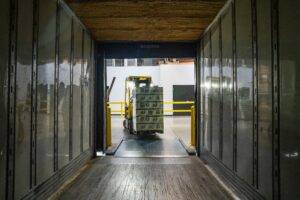Today, transportation and logistics services are exploding in popularity since supply chain management is an essential component of many industries. It is utilized to organize and coordinate the transport of items in an effective, safe, and timely manner. But have you ever thought about the procedure logistics businesses use to ensure that their shipping services are of the highest possible standard?
I do not doubt that many of you are entirely oblivious to the situation.
The term “shipping” is used rather frequently, but what does it actually mean? The act of transporting things from one location to another is what most people comprehend when they hear the term “shipping.” However, the process of shipping involves a significant number of phases, and it is possible to ship items using a variety of different means of transportation. In this post, we will talk about how the shipping process works so that you will better understand the many factors involved.
Let’s take a quick look at the method that transportation businesses need to follow to give you better services. But first, let’s check out what shipping is.
What is Shipping?
Transporting things from one location to another is what we mean when we talk about shipping. To be more exact, it refers to the process of moving products from the warehouse of a firm to the hands of the clients of that company. The act of shipping involves several discrete operations or steps, each of which may entail interactions with both internal and external parties.
Shipping logistics manages these activities’ procedures, actions, and relationships. Take, for instance, the process of delivering items to a consumer from a fulfillment center. The procedures that occur when objects move through the supply chain, including documentation, dealing with carriers, tracking, handling, and delivery periods, are referred to as shipping. Transportation is another component of shipping.
Road Shipment
Road transport, which refers to shipments made by truck, is one of the most prevalent modes of transport for goods all over the world. This is due to the fact that road transport is more cost-effective than other forms of transport, especially air transport. Additionally, it enables better accessibility because the majority of businesses have access to major highway systems, and it provides almost an infinite number of possible ways to proceed.
The following is a list of the various forms of road transport:
- Transportation With Curtains
It’s a prevalent mode of transportation on the roads. This transport option combines the security of a vehicle or box truck with the adaptability of a flatbed.
- Flatbed Transportation
It facilitates the usage of cranes and forklifts in the loading process, is applicable in a wide variety of contexts, and speeds up and simplifies the loading of items.
Cargo that needs to be kept at a constant temperature and humidity can be shipped. Due to its fragility and high market value, the cargo requires precise temperature regulation.
- Delivery Using Box Trucks Or Containers
It has a covered space for transporting goods. Depending on the size of the box truck, it can be used to transport cargo ranging in size from small to medium to huge.
- Project Cargo Transportation
Freight transport with flatbed trucks is a special kind of road freight used to move very large shipments.
Rail shipment
One of the first forms of transportation, rail, also known as shipments made by train, is ideal for moving heavy, bulky items and huge numbers across extended distances. Trains run on their own dedicated tracks, and their schedules are carefully set to reduce the likelihood of congestion and delays. As a result, rail transportation offers a service that is both quick and dependable.
Shipment By Ocean
The term “ocean freight forwarding” refers to shipments on the ocean or by ship. It entails packing commodities into shipping containers before loading them onto ships that travel across the water. Companies are able to move goods in vast quantities as well as large sizes and weights across international borders thanks to this essential component of international trade.
Air Shipment
When it comes to shipping or carrying things around the world in the shortest time, the most valuable mode is air transportation, often known as shipments by plane. Gateways for commercial or passenger aircraft can be used to send cargo to any area in the world where an airplane can take off and land.
Each of these transportation methods comes with its own set of advantages, and to select the mode that will be most beneficial to your company, you will need to give it a lot of thought. The shipping type that is finally chosen is contingent on several different considerations.
What Are the 3 stages of the Shipping Process?
The three steps that make up the process of shipping are called “receiving,” “processing,” and “fulfillment,” respectively. These steps have an effect on how fast and accurately a customer order can be prepared, as well as how quickly and directly it can be transported to its final destination. The following is an in-depth look into the various phases that comprise the shipping process.
1. Receiving the Order
Once you have received an order, you will need to check to see if you have sufficient inventory on hand to fulfill the order in its entirety. This starts with working closely with your manufacturer or supplier to purchase and receive inventory at a warehouse. Alternatively, collaborating with a third-party logistics provider can ship merchandise to a fulfillment center.
Implementing an order management system or inventory management software that syncs with your eCommerce platform is a simple way to streamline the process of receiving customer orders. This might assist you in keeping track of orders and inventory in a single location.
2. Processing the Order
To ensure that a customer’s order is processed successfully, it must first be checked to ensure that the information provided is correct (such as the shipping address) and that the products being ordered are, in fact, available. As a result, the order processing phase can be shortened by extensive use of automation and technological aids. There, clients can receive a quick update on the status of their order and be informed when it has shipped.
3. Fulfilling the Order
The order will not be considered complete until the processing stage has been completed. This step requires selecting the right items for the order and getting them ready to be dispatched. Many alternative order filling options are available for businesses, such as self-fulfilling orders or drop shipping. Still, the most common choice is to outsource fulfillment to a 3PL, also known as a third-party logistics partner.
A third-party logistics provider, or 3PL, is an organization that will handle all aspects of the enterprise fulfillment process on your behalf. This includes warehousing, the creation of picking lists, the packing of boxes, and the shipment of orders. Compared to self-fulfillment, which comes with several hidden charges, and dropshipping, which comes with a list of obstacles, working with a 3PL can help you save time, automate delivery, and keep your logistics costs down.
The Process Follow For Shipping and Logistics
Shipping involves many distinct processes, workflows, and interactions, all of which require unique procedures, making shipping logistics indispensable. As part of the usual shipping process, you can expect to encounter the following:
- Packing list and shipping paperwork creation
- Picking the goods
- Packing for transport
- Selection of best mode of transport
- Loading of the goods
- Management of returns, if applicable
Timing and budget are two of the most critical considerations in shipping, which is a multi-step operation with many moving parts and variables. Good shipping operations are crucial to the smooth delivery of products from the manufacturer to the consumer.
Collaborate With Experts For Best Services
I-Way Transport is the company to call when your business requires transportation services that are prompt, effective, and secure for its goods. We provide one-of-a-kind solutions for transporting freight in Canada that are fueled by statistics, supported by data, and tailored to meet your company’s requirements specifically. I-Way Transport is a full-service logistics provider that offers all available methods of transporting goods and maintains warehouses all around the country.
We will work with you as a partner to develop a transportation strategy explicitly tailored to your requirements. This will free you up to concentrate on expanding other aspects of your business operations. Get in touch with I-Way Transport at this very moment in order to obtain further information on the logistics transportation solutions that we provide.




